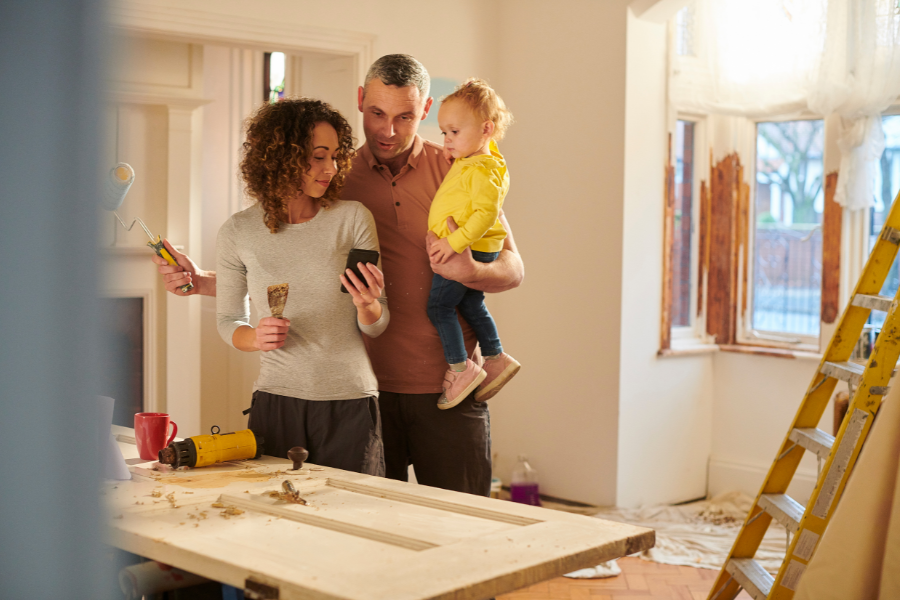
When it comes to transforming our homes into cozy sanctuaries or increasing their market value, house renovations are a go-to solution. But what often goes unnoticed amidst the excitement of choosing paint colors and flooring options is the significant impact these renovations can have on IAQ standards.
Let’s delve into the relationship between house renovation and air quality, offering practical advice on minimizing indoor air pollutants during this period. We will also introduce uHoo, a cutting-edge air quality monitoring device, as a valuable tool to ensure a healthy home environment.
The Renovation Paradox
House renovations are a great way to breathe new life into our living spaces. However, they can also increase indoor air pollution by introducing a host of pollutants. These toxins lead to a less-than-healthy living environment since their presence means your space doesn’t meet indoor air quality guidelines. Here are some common culprits:
- Dust and Particles
Demolition and construction work generate copious amounts of dust and particles. These can contain allergens, such as pollen and mold spores, exacerbating respiratory issues.
- Volatile Organic Compounds (VOCs)
VOCs are chemicals in paints, solvents, adhesives, and many building materials. These compounds can be released into the air during and after renovations, leading to headaches, eye irritation, and long-term health issues.
- Formaldehyde
This compound, found in pressed wood products, carpets, and insulation materials, can be released into the air during renovations. It is a known carcinogen and can also cause respiratory problems.
- Asbestos
Older homes may contain asbestos, a mineral fiber used in insulation and other construction materials. When disturbed during renovations, asbestos fibers can become airborne, posing a severe health risk as it could lead to cancer.
Minimizing Renovation-Related Air Pollution
Now that we understand the potential hazards, it’s essential to take steps to minimize the impact of house renovations on indoor air quality. Here are some effective indoor air quality strategies:
- Plan Ahead
Start by planning your renovation project meticulously. Consider conducting air quality tests with an IAQ sensor before you begin to establish a baseline. This will help you track changes throughout the renovation process.
- Ventilation
One of the best and simplest IAQ solutions is to ensure proper ventilation during the renovation. Use exhaust fans and open windows. Doing so creates negative air pressure zones that direct contaminants out of the living areas.
- Dust Control
Implement dust control measures, such as sealing off renovation areas with plastic sheeting. Use IAQ products for indoor air cleaning, like using HEPA filters in HVAC systems, frequent vacuuming, or running an air purifier.
- Choose Low-VOC Materials
Opt for low-VOC or VOC-free paints, adhesives, and building materials. Look for products with certifications like GreenGuard or LEED.
- Professional Asbestos Removal
If your home contains asbestos, consult professionals for safe removal and disposal. Never attempt to handle asbestos-containing materials yourself.
Use an Indoor Air Quality Guardian
While following these precautions is essential, having real-time information about your indoor air quality during and after renovation is invaluable. This is where uHoo comes into play. It’s an advanced indoor air quality monitor that continuously tracks the air you breathe.
Its indoor air quality sensors measure various parameters, including VOCs, particulate matter, temperature, humidity, etc. This device allows you to access real-time data and receive alerts when air quality deteriorates. Here’s how uHoo can help during renovations:
- Monitoring VOC Levels: uHoo can detect elevated VOC levels, alerting you to potential exposure and allowing you to take immediate action.
- Particulate Matter Tracking: Keep an eye on dust and particle levels to assess the effectiveness of your dust control measures.
- Temperature and Humidity Control: uHoo helps you maintain an optimal environment for your renovation project.
- Post-Renovation Air Quality: After completing the project, uHoo can help ensure air quality returns to a healthy baseline.
Final Thoughts
House renovations can be transformative, but they can also disrupt your indoor air quality. By planning carefully, following best practices for minimizing pollutants, and using uHoo to monitor your indoor air quality, you can create a healthier and more comfortable living environment for you and your family. Breathe easy, and enjoy your newly renovated home with peace of mind.
